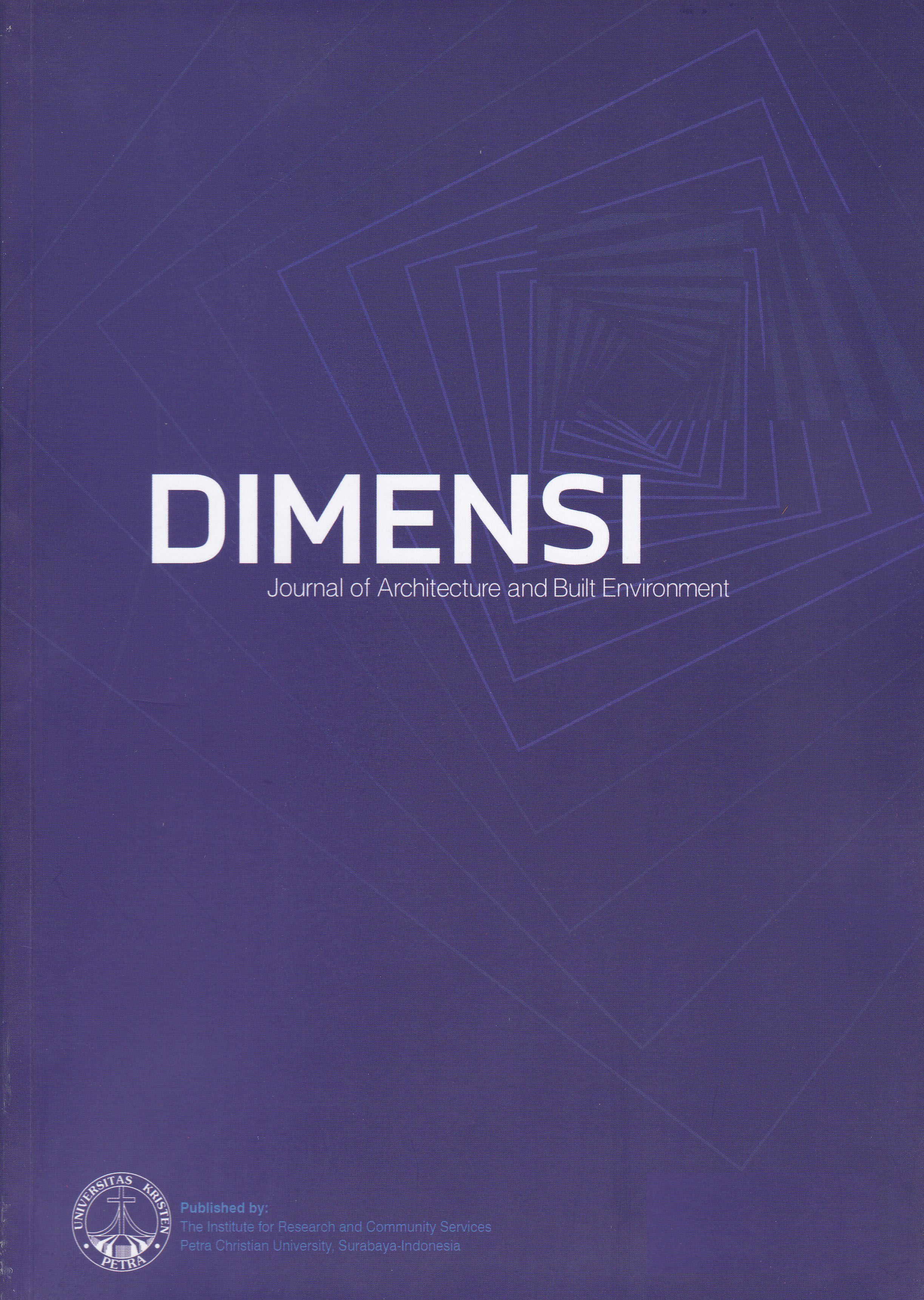IMPACT OF SIMPLE VIRTUAL TECHNOLOGY APPLICATION IN ARCHITECTURAL EDUCATION
 :
:
https://doi.org/10.9744/dimensi.48.2.87-96
Keywords:
Virtual reality, augmented reality, architectural presentationAbstract
The development of technology cannot be separated from the development of science, including the learning method. There is an elective course named Virtual Reality Architecture in Architecture Department of Petra Chrisitan University. This course focuses on the process of learning architecture at the stage of presenting and communicating ideas. The virtual technology used as a learning method includes three types of technology, animation, augmented reality and virtual reality. The three technologies are elaborated as a simulation method. The simplicity of its application can be seen in the support for hardware, software, and special devices used by students in their daily lives. This study aims to test the achievement of goals at the final level of learning. Students who have attended this lecture are then interviewed and observed, in relation to proving whether this simple virtual technology can be a supporter in the learning process in the architecture study program.
Downloads
References
Aslesen, H. W., Martin, R., & Sardo, S. (2019). The virtual is reality! On physical and virtual space in software firms’ knowledge formation. Entre-preneurship and Regional Development, 31(9–10), 669–682. https://doi.org/10.1080/08985626. 2018.1552314
Battista, K. (2021). The White Cube in Virtual Reality. Architectural Design, 91(3), 102–111. https://doi.org/10.1002/ad.2699
Canizares, G. (2020). Technologies of the Virtual Other: Bodies, Users, and Avatars. Journal of Architectural Education, 74(2), 237–249. https://doi.org/10.1080/10464883.2020.1790933
Ceylan, S. (2020). Using virtual reality to improve visual recognition skills of first year architecture students: A comparative study. CSEDU 2020 - Proceedings of the 12th International Conference on Computer Supported Education, 2(Csedu), 54–63. https://doi.org/10.5220/00093 46800540063
Chang, D., & Szalapaj, P. (2000). A study of digital presentation techniques in architecture.
Chaturvedi, A. R., Dolk, D. R., & Drnevich, P. L. (2011). Design principles for virtual worlds. MIS Quarterly: Management Information Systems, 35(3), 673–684. https://doi.org/10.2307/230428 03.
D’Errico, M. (2021). Immersive Virtual Reality as an International Collaborative Space for Innovative Simulation Design. Clinical Simulation in Nursing, 54, 30–34. https://doi.org/10.1016/j.ecns. 2021.01.005
Goldman, G., & Zarzycki, A. (2010). Digital Media in Architecture and Interior Design - Curriculum Framework REPORT FOR THE SIGGRAPH EDUCATION COMMITTEE Digital Media in Architecture and Interior Design - Curriculum Framework.
Graafland, A. (2012). Architecture, Technology and Design. Digital Studio for Research in Design, Visualization and Communication.
Harris, J. (1998). Virtual Architecture: Designing and Directing Curriculum-Based Telecomputing (Issue 1988).
Hong, S. W., El Antably, A., & Kalay, Y. E. (2019). Architectural design creativity in Multi-User Virtual Environment: A comparative analysis between remote collaboration media. Environ-ment and Planning B: Urban Analytics and City Science, 46(5), 826–844. https://doi.org/10.1177/ 2399808317733267
Iranmanesh, A., & Onur, Z. (2021). Mandatory Vir-tual Design Studio for All: Exploring the Transformations of Architectural Education amidst the Global Pandemic. International Journal of Art and Design Education, 40(1), 251–267. https://doi.org/10.1111/jade.12350
Lavalle, S. M. (2017). The Book of Virtual Reality. In Cambridge University Press.
Mihelj, M., Novak, D., & Beguš, S. (2014). Virtual Reality Technology and Applications. Intelligent Systems, Control and Automation: Science and Engineering.
Mintorogo, D. S. (2000). ARSITEKTUR DVD (Digital Virtual Design). Jurnal Arsitektur DIMENSI, 28(1), 24–30. https://doi.org/10.9744/ dimensi.28.1.
Mitchell, W. J. (1995). The Future of the Virtual Design Studio. In Virtual Design Studio (pp. 51–59). Hong Kong University Press. http://www. jstor.org/stable/j.ctt2jc401.13
Plowright, P. (2014). Revealing architectural design : methods, frameworks and tools. Routledge.
Putro, H. (2015). Immersive Virtual Reality for Tourism and Immersive Virtual Reality for Tourism and Creative Industry Development. International Conference on Creative Industry, August, 1–6. https://doi.org/10.13140/RG.2.1. 2102.0002.
Putro, H. T., Yogyakarta, U. T., Reality, V., An, A., For, A., & Heritage, D. (2015). Kajian Virtual Reality Makalah Studi Mandiri Kajian Virtual Reality Program Studi Teknik Arsitektur dan Perencanaan Oleh Pembimbing : Ir . Jatmika Adi Suryabrata., MSc., Ph . D . January.
Sapto Pamungkas, L., Meytasari, C., & Trieddiantoro, H. (2018). Virtual Reality As A Spatial Expe-rience For Architecture Design: A Study of Effectiveness for Architecture Students. SHS Web of Conferences, 41, 05005. https://doi.org/ 10.1051/shsconf/20184105005.
Stonorov, T. (2018). Introduction. In The Design-Build Studio. https://doi.org/10.4324/978131 5650746-1.
Syafril, R. S. (2019). Penerapan Sederhana Virtual Reality Dalam Presentasi Arsitektur. NALARs, 19(1), 29. https://doi.org/10.24853/nalars.19.1. 29-40.
Wake, W. K., & Levine, S. L. (2002). Complemen¬tary virtual architecture and the design studio. Journal of Architectural Education, 56(2), 18–22. https://doi.org/10.1162/10464880260472530
Webster, B. (1997). The Identity of Place. Medieval Scotland, 9–20. https://doi.org/10.1007/978-1-349-25402-6_2.
Downloads
Published
How to Cite
Issue
Section
License
Authors who publish with this journal agree to the following terms:
- Authors retain copyright and grant the journal right of first publication with the work simultaneously licensed under a Creative Commons Attribution License that allows others to share the work with an acknowledgement of the work's authorship and initial publication in this journal.
- Authors are able to enter into separate, additional contractual arrangements for the non-exclusive distribution of the journal's published version of the work (e.g., post it to an institutional repository or publish it in a book), with an acknowledgement of its initial publication in this journal.
- Authors are permitted and encouraged to post their work online (e.g., in institutional repositories or on their website) prior to and during the submission process, as it can lead to productive exchanges, as well as earlier and greater citation of published work (See The Effect of Open Access).



















